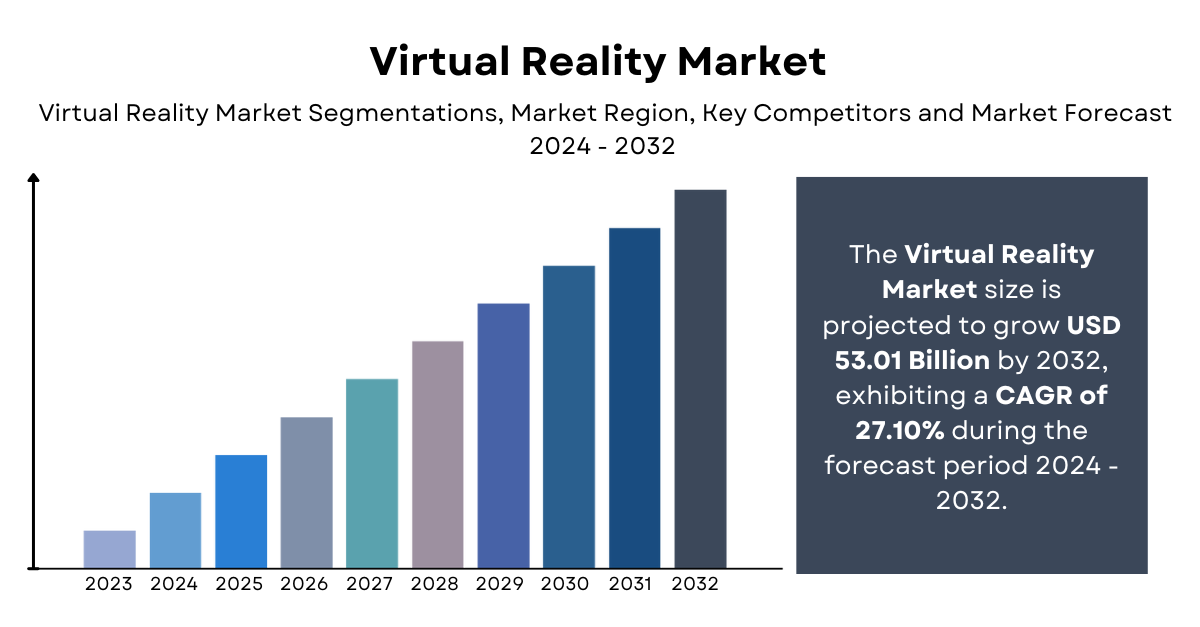Virtual Reality Market Overview:
The virtual reality (VR) market has experienced exponential growth over the past decade, transforming from a niche technology into a mainstream phenomenon. Virtual reality immerses users in a computer-generated environment, offering experiences that range from gaming and entertainment to education and training. This immersive technology has applications across numerous industries, including healthcare, real estate, automotive, and retail. The Virtual Reality market size is projected to grow from USD 7.78 billion in 2024 to USD 53.01 billion by 2032, exhibiting a compound annual growth rate (CAGR) of 27.10% during the forecast period (2024 - 2032). This growth is driven by advancements in VR hardware and software, increasing investment in VR technology, and the rising demand for immersive experiences.
Get a sample PDF of the report at –
https://www.marketresearchfuture.com/sample_request/916
Industry News:
The VR market is constantly evolving, with significant advancements and innovations shaping its trajectory. In recent years, major tech companies like Facebook (now Meta), Google, Sony, and Microsoft have made substantial investments in VR technology, pushing the boundaries of what is possible. Meta’s Oculus Quest 2 has become a leading VR headset, praised for its wireless capabilities and user-friendly interface. In 2023, Apple announced its foray into the VR market with the anticipated release of its mixed reality headset, aiming to revolutionize user interaction with digital content. Additionally, partnerships and collaborations among tech giants and startups are fostering innovation, expanding VR applications, and driving market growth.
Market Segmentation;
The VR market can be segmented based on component, technology, device type, and application.
Component: The VR market is divided into hardware and software segments. The hardware segment includes head-mounted displays (HMDs), controllers, sensors, and input devices, while the software segment encompasses VR content creation and development tools, and VR applications.
Technology: VR technology can be categorized into non-immersive, semi-immersive, and fully immersive VR. Fully immersive VR, which offers a more lifelike experience, is witnessing significant demand, particularly in gaming and entertainment.
Device Type: VR devices are classified into standalone, tethered, and smartphone-enabled devices. Standalone devices, like the Oculus Quest 2, are gaining popularity due to their convenience and ease of use.
Application: VR has diverse applications across various sectors, including gaming and entertainment, healthcare, education and training, real estate, automotive, and retail. The gaming and entertainment sector currently dominates the market, but VR’s use in healthcare and education is rapidly expanding, offering promising growth opportunities.
Request for customization of this research report at -
https://www.marketresearchfuture.com/ask_for_customize/916
Market Key Players:
The VR market is highly competitive, with key players continually innovating to gain a competitive edge. Major companies in the market include:
- Meta Platforms
- Sony Corporation
- HTC Corporation
- Microsoft Corporation
- Google LLC
Regional Analysis:
The VR market exhibits regional variations in growth and adoption rates.
North America: North America dominates the VR market, driven by high adoption rates, significant investment in VR technology, and the presence of major tech companies. The U.S. is the largest market in this region, with widespread use of VR in gaming, healthcare, and education.
Europe: Europe is a significant market for VR, with countries like the UK, Germany, and France leading in VR adoption. The region benefits from strong technological infrastructure and growing interest in VR applications in various industries.
Asia-Pacific: The Asia-Pacific region is witnessing rapid growth in the VR market, fueled by increasing consumer demand, rising disposable incomes, and significant investments in VR technology. China, Japan, and South Korea are key contributors to the market growth in this region.
Latin America and Middle East & Africa: These regions are emerging markets for VR, with growing interest and investment in VR technology. While the adoption rate is currently lower compared to other regions, there is significant potential for growth.
Browse a Full Report –
https://www.marketresearchfuture.com/reports/virtual-reality-market-916
Recent Developments:
Recent developments in the VR market highlight the technology’s dynamic nature and its expanding applications. In 2022, Meta introduced several updates to its Oculus Quest platform, enhancing user experience and adding new features. Sony announced the PlayStation VR2, promising improved graphics and performance for an even more immersive gaming experience. The healthcare industry is also seeing innovative VR applications, such as VR-based therapy for mental health conditions and VR-assisted surgeries. Additionally, VR in education is gaining traction, with virtual classrooms and training simulations becoming more common.
The virtual reality market is poised for remarkable growth, driven by technological advancements, increasing investments, and expanding applications across various industries. As VR technology continues to evolve, it promises to revolutionize the way we interact with digital content and reshape numerous sectors, offering immersive and transformative experiences.
Top Trending Reports:
Cloud Infrastructure Services Market
Wireless Intrusion Prevention System Market
Contact
Market Research Future (Part of Wantstats Research and Media Private Limited)
99 Hudson Street, 5Th Floor
New York, NY 10013
United States of America
+1 628 258 0071 (US)
+44 2035 002 764 (UK)
Email: sales@marketresearchfuture.com
Website: https://www.marketresearchfuture.com



